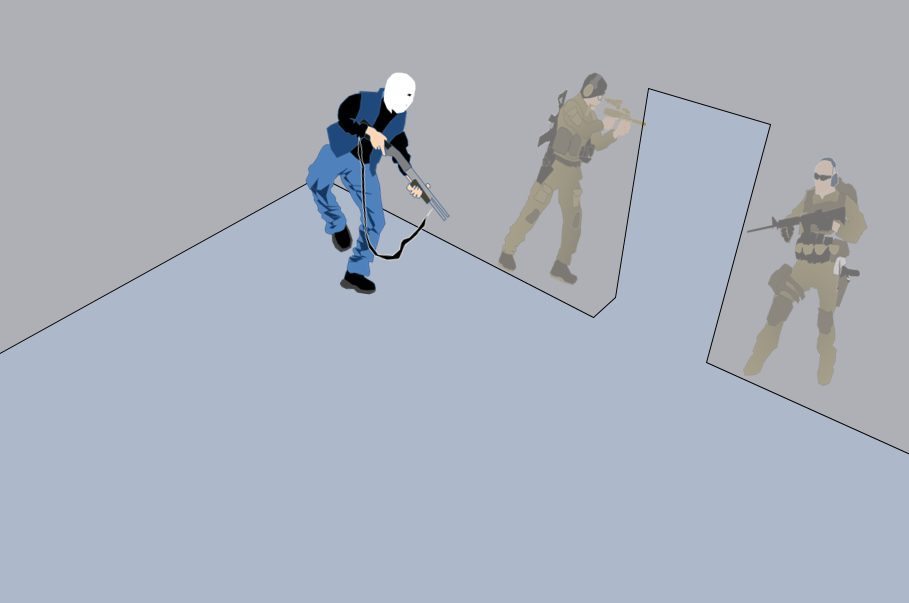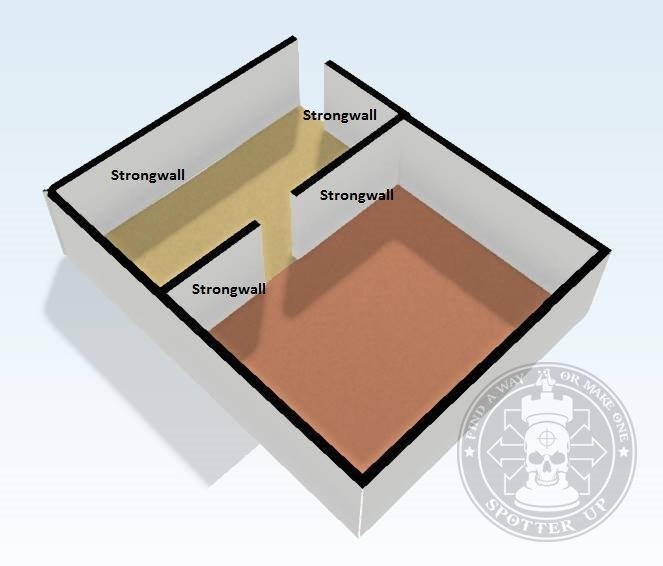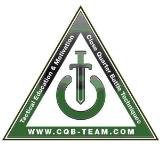Anatomy of the Room Part 3
The corners are our main areas to clear in a bog-standard “traditional” entry as discussed in the last article. This part of the series will look into the tactical significance of the room anatomy in relation to humans, as well as a few more minor structural concepts that are not “concrete anatomy.” To start off we will further discuss corners. Are your ears bleeding yet? Get used to it.
Corners are the areas we clear in our primary sweep. We know that. So what? Well… Corners in relation to human beings are areas people tend to “hug” in certain circumstances. If they are under immediate danger, in a firefight under fire, they feel they cannot defend the room effectively, threatened or they feel they will gain surprise by being in a corner they will “hug” it. It makes them feel safer – solid walls either side of them with only one area to look at. Cosy. It’s bad news for us. We enter against someone trained on the entrypoint who may feel safe, even confident, in the most vulnerable position. A d*#head with an AK can kill a million-dollar super soldier from this position. You see that I am trying to project importance in clearing the corners. Clear them effectively.
They may hug the corner with the biggest field of view of the entrypoint – the soft corner. They may use cover and barricade themselves in this way using deep angles within the room. They may want to stay out of sight, relying on surprise from the hard corner. From this position they may not be barricaded, they may be sitting “exposed” in the corner with no cover. If you clear the soft corners from outside then you can conduct a targeted approach to the hard corners. Now you see why understanding these differences in corners becomes significant. At least I should hope you do.
Well you have a few more areas to think about – the first being the immediate threat area and from there on usually the corners and then the rest of the room. This is known as a “center-corner-center” approach. We’ve already discussed corners so let’s take it back a step… The immediate threat area.
The immediate threat area can be seen as the an area close to the entrypoint where an enemy may engage the entry team or obstruct the entry. If an enemy is within this area or looks to obstruct your entry they are known as immediate threats. The definition of the immediate threat is:
– A person armed and prepared to fire upon entry team; and,
– If not eliminated or subdued they will cause harm to the entry team or entry process.
Other definitions further describe an immediate threat as:
– A person who blocks movement of the entry team; and,
– Are within an arm’s reach of the entrypoint.

They are not imminent threats. An imminent threat is impending or likely danger that is separated by space or time. An immediate threat does not have this luxury, it is actively happening in real-time. It is a present danger that is next in order, without delay. For example an imminent threat may be running across the room to grab his rifle. That is meters away and a few vital seconds. Imminent. Whereas an immediate threat has the rifle in hand and is ready to operate it. A potential threat, furthering this point, is someone who may potentially become dangerous in the future and thus is treated as a threat for the short-duration until defined.
Now an immediate threat area is not the “base anatomy” or “concrete anatomy” of the room. It is a tactical concept superimposed on the anatomy. The immediate threat area is concept of how humans use the anatomy. It is equally as important to know as understanding the “base” or “concrete anatomy.” Hence it has tactical significance. Eliminate immediate threats, if you can, as soon as possible. Even before the hard corners.
We understand that the immediate threat area and hard corners are our initial targets. Usually the first two men entering will clear into these areas first. But how do we do this without hurting one another? How do we use the anatomy to prevent risk, especially if we have to engage somebody in front of us?

To prevent any mishap with the third and fourth man entering after first and second or the pointman and secondman progressing too far into the room, there is a key fundamental: the strongwall. “Sticking to the strongwall”, or strongwalling, minimizes the risk of friendly fire (blue-on-blue), allows for a co-ordinated entry into the room and maximizes the visible area in the room.
The strongwall, or the common wall, is the wall along the entrypoint. In a corner-fed this may include both walls connecting to the door but under normal circumstances it is one individual wall. Example – in some entries you run along both known walls and only the walls attaching to the original entrypoint wall. If this is done correctly there should be safe firing lanes as to avoid each other. You may have seen some of the “Special Forces Room Clearing” videos on Youtube. One of them examples this perfectly. You see comments on it saying, “Wow I’m like sooo amazed they like didn’t like shoot each other.” Well. That’s why. Pretty simple concept, huh?
Now the strongwall is a dynamic process and hence why I have not included it as apart of the “concrete” anatomy but as an area of the anatomy we mentally visualize and use to our advantage. The strongwall may be going to the left, going to the right, one wall, two walls. It all depends on what the room anatomy is telling us. The purpose is that you remain on the same wall as the entrypoint, lock down and engaging threats within that room without leaving the wall. This is the concept of strongwalling.
Basic Concepts
Immediate threat area – An area which can be close to the entrypoint but definitely has access of which to visualize and engage the entrypoint.
Immediate threat – A person prepared and capable of causing immediate harm to the entry team, usually within seconds, or as, the entry team enters the room.
Imminent threat – A person not yet capable of causing immediate harm but is actively seeking the capability to do so. For example moving towards a weapon or from the other side of the room towards the entry team.
Potential threat – A person who may have the capacity to cause harm, they are potentially dangerous. This is why all hostages get the zippy and a hostage controller looking over them, folks.
Strongwall – The wall running along the entrypoint. “Strongwalling” is a tactic in which all members of the entry team stay along the strongwall to lock down and engage threats.
We get out we use the anatomy now and how the room anatomy relates to human beings. The next article will cover some of the further obstacles we may face that encompass the anatomy of the room. These obstacles might catch you by surprise.
By Rye
CQB-TEAM
Close Quarters Battle
Tactical Education and Motivation
Google anything Close Quarter Battle – You’ll find us!
http://www.facebook.com/CQBteam



[…] Anatomy of the Room Part 3 […]